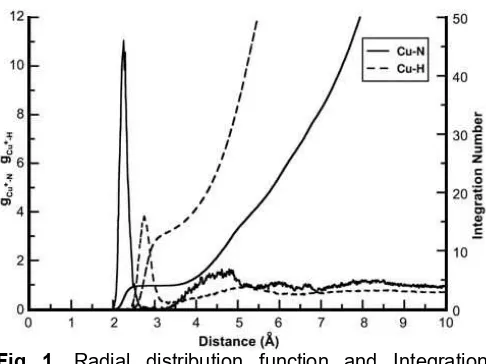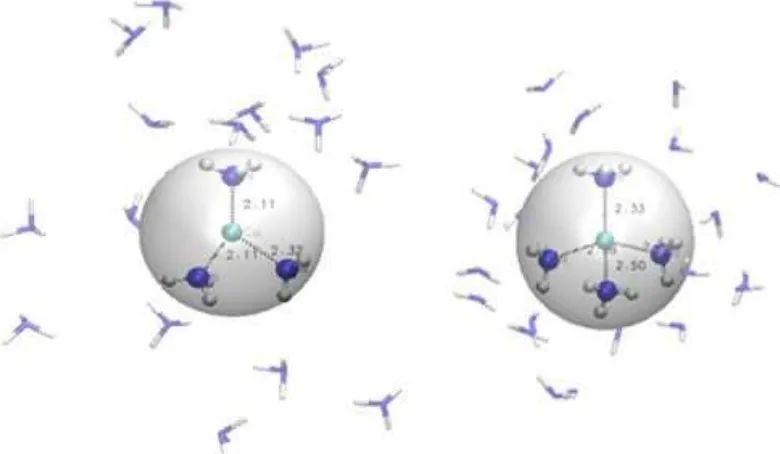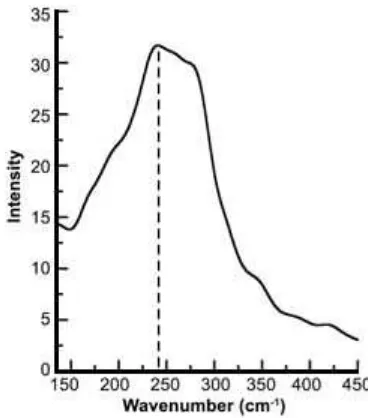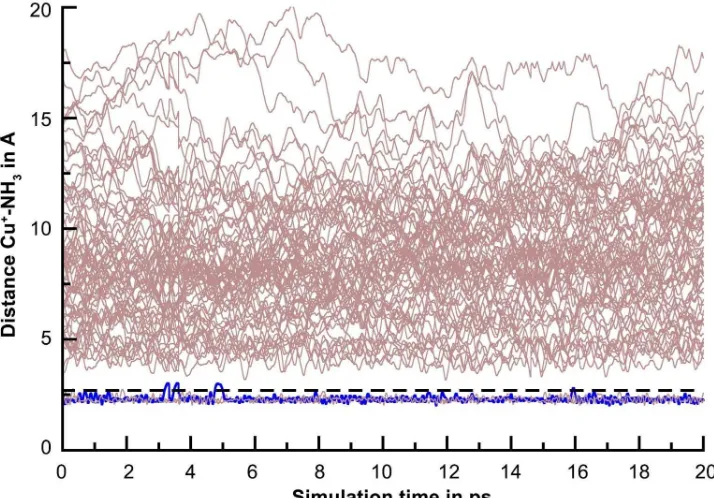Investigation of the Structural and Dynamical Properties of Cu
+in Liquid Ammonia:
A Quantum Mechanical Charge Field (QMCF) Molecular Dynamics Study
Wahyu Dita Saputri
1,2, Karna Wijaya
1, and Ria Armunanto
1,2,*1Department of Chemistry, Faculty of Mathematics and Natural Sciences, Universitas Gadjah Mada,
Sekip Utara, Yogyakarta 55281, Indonesia
2Austrian-Indonesian Center for Computational Chemistry, Universitas Gadjah Mada,
Sekip Utara, Yogyakarta 55281, Indonesia
Received July 21, 2017; Accepted October 24, 2017
ABSTRACT
A quantum mechanical charge field (QMCF) molecular dynamics (MD) simulation has been carried out to describe the structural and dynamical properties of Cu+ ion in liquid ammonia. The first and second shells were
treated by ab initio quantum mechanics at the Hartree−Fock (HF) level with the DZP-Dunning basis set for ammonia
and LANL2DZ ECP basis set for Cu. The system was equilibrated for 4 ps, then the trajectory data was collected every fifth step for 20 ps at 235.15 K. The structural analysis showed that in the first solvation shell, Cu+is solvated
by 4 ammonia molecules forming a stable structure of tetrahedral with Cu-N bond length of 2.15 Å, whereas in the second solvation shell there are 29 ammonia molecules that have an average distance of 4.79 Å to Cu+ion. Mean
residence time of 3.06 ps was observed for the ammonia ligand in the second solvation shell indicating for a highly unstable structure of the solvation shell. The obtained structure of the first solvation shell from this simulation is in excellent agreement with experimental data.
Keywords:structural; dynamical; Cu+ion; liquid ammonia; QMCF
ABSTRAK
Simulasi dinamika molekuler (DM) quantum mechanical charge field (QMCF) telah dilakukan untuk mendeskripsikan sifat struktur dan dinamika ion Cu+ dalam amonia cair. Kulit solvasi pertama dan kedua dihitung
dengan mekanika kuantum ab initio pada tingkat Hartree Fock (HF) dengan basis set DZP-Dunning untuk molekul amoniak dan LANL2DZ ECP untuk ion Cu+. Sistem dilakukan ekuilibrasi selama 4 ps, kemudian data dihimpun
setiap 5 tahap selama 20 ps pada temperatur 235,15 K. Analisis sifat struktur menunjukkan pada kulit solvasi pertama, ion Cu+ tersolvasi oleh 4 molekul amonia membentuk geometri tetrahedral yang stabil dengan panjang
ikatan Cu-N sebesar 2,15 Å, sedangkan di kulit solvasi kedua terdapat 29 molekul amoniak yang memiliki jarak rata-rata sebesar 4,79 Å terhadap ion Cu+. Waktu tinggal rata-rata ligan amoniak selama 3,06 ps pada kulit solvasi kedua
mengindikasikan jika struktur yang terbentuk sangat tidak stabil pada kulit solvasi ini. Sifat struktur pada kulit solvasi pertama dari simulasi ini memiliki data yang sangat sesuai dengan data eksperimen.
Kata Kunci:struktur; dinamika; ion Cu+; amonia cair; QMCF
INTRODUCTION
Structural and dynamical properties of copper ion that interact with a small ligand such as ammonia become an interesting object to study. Utilization of Cu+ ion is extensive and applicable, such as the manufacture of ultrasensitive molecular sensor that leads to a better Raman signal enhancement [1], next-generation of OLED technology [2], supporting surface in a self assembled monolayer [3], and helping mammalian immune system to fight bacterial pathogens [4]. Cu+ion also has a major role in several redox reactions and catalytic system [5-6].
configuration, it indicated a labile structure. Complexes of Cu+(NH
3)nwith the larger number of NH3molecules (n = 6–8) had specific characteristic due to all of these complexes had di-coordinated form. Two ligands directly interact with Cu+ ion, and the others formed hydrogen bonding to other ligands in second solvation shell. The experimental analysis only provided structural data, but could not explain the dynamics of the ligand in both the first and second solvation shell [7].
Three coordinated structure of Cu+ in liquid ammonia were obtained from X-ray absorption fine structure (EXAFS) spectroscopy. The average distance of Cu-N is 2.004 Å [8]. The stability of Cu-NH3complex system also has been calculated via the dissociation energy using ion beam mass spectrometer. The stable complex of [Cu(NH3)2]+ has high dissociation energy, and third NH3 molecule has the sterically hindered, together with the tendency of Cu+to form di-coordinated complexes in aqueous solutions [9].
The computational calculations have been carried out using DFT method at B3LYP/6-311+G(2df) level showing stable structures of [Cu(NH3)3]+, almost equivalently Cu–N bond lengths (2.06, 2.07, and 2.07 Å) and N–Cu+–N angles of 120°. The [Cu(NH3)3]+ hardly persists in the linear coordination, and the 4s–3d hybridization was greatly reduced in [Cu(NH3)3]+[7].
Although this research has been widely studied, yet it has not provided information of the dynamical first and second solvation shell of Cu+ ion in liquid ammonia. As the development of advances in computational chemistry, molecular dynamics simulation method with a larger region including the second shell can be accommodated the quantum mechanical simulation with better accuracy, especially in the study of dynamical properties of solvated metal ions [10].
The quantum mechanical charge field (QMCF) molecular dynamics simulation is development of quantum mechanics/molecular mechanics (QM/MM) conventional method that has the advantage of not requiring potential functions [10]. QMCF method using partial atomic charges were derived from quantum mechanics and incorporate the point charges from MM to QM region through the presence of an impaired function of the Hamiltonian [11].
The study of dynamical properties of Cu+ ion in liquid ammonia is important to investigate due to a wide applied in various facets of life. The QMCF method can characterize rapid ligand displacement dynamically both on the first and second solvation shell. In this paper, QMCF method is used to investigate solvation structure and dynamical properties of Cu+ in liquid ammonia during simulation time of 20 ps, especially in the second shell due to previous experimental and computational studies can not provide this data.
COMPUTATIONAL METHOD
General
The QMCF method divides the solvation shell into two subregions, there are QM and MM. QM region is set larger than in QM/MM conventional method and divided into two sub-zones, there are QM core and QM layer zone. The QM core zone includes the solute and its first solvation shell, and the layer zone contains the molecules of the second solvation shell. By extending the QM region to include first and second solvation shell, a more realistic representation of the system was achieved yielding improved results. Due to the longer distance of solute-MM interactions, non-Coulombic potentials between the solute located at the center of the QM region and solvent molecules located in the MM region are not required to the model of the system and provides a more accurate description [12-13].
The point charges of all MM particles are included in the core Hamiltonian as a perturbation potential to accommodate the charge embedding and to obtain a more realistic description of the influence of surrounding solvent molecules on the QM region. Details of the QMCF-MD technique is published elsewhere [14].
To evaluate the dynamics solvation structure aspects of the solvate, radial distribution function (RDF), coordination number distribution function (CND), and angular distribution function (ADF) were employed. Dynamical properties such as mean residence time (MRT) is calculated via the direct method [15].
The RDF is the fundamental analysis performed to elucidate the structural characteristics of solutions. This property is dimensionless quantity represented as gr which gives the prabability of finding a particle j at a distance r from another particle i compared to the ideal distribution.
where rijis the separation between particles i and j, and
denotes the Dirac delta function, N is the total number of a given type of particle within the volume V. r indicates the radial distance, V/NiNj is a normalization factor to the RDF relative to an ideal gas of the same density [16].
tsim represents duration of the simulation, Nav is the average coordination number of particles in the respective shell and N0.5ex is number of exchanges with a ligand displacement time of 0.5 ps. To acquire the average number of successful exchange between the second solvation layer and bulk, a statistical value Rex was calculated by the ratio of the total number of exchange (minimum displacement time 0.0) and the number of exchanges with a displacement of change persisting after 0.5 ps (Eq 3).
0.0
The Fourier transform of the respective velocity autocorrelation functions (VACFs) was evaluated to investigate the stretching frequency of the Cu–N vibrational mode, where C(t) give direct insight into the dynamics of a fluid system as the time integrals are related to macroscopic transport coefficient (Eq 4).
QMCF method accesses the positions of all atoms and their time evolution. Therefore QMCF method can characterize rapid ligand displacement dynamically both on the first and second solvation shell.
Simulation Protocol
The QMCF molecular dynamics simulation was performed using a simulation box with 34.52 Å side length consisting of a Cu+ ion and 999 ammonia molecules. The radius of QM region was set to 6.6 Å including a smoothing zone of 0.2 Å to ensure a continuous transfer of solvent molecules between the QM and MM regions. The density system was fixed corresponding to the experimental density of liquid ammonia of 0.693 g cm-3 at 235.15 K. The simulations was carried out by applying NVT ensemble with periodic boundary conditions. Adam-Bashforth predictor-corrector algorithm second order with a time step of 0.2 fs was used used to correct the cutoff of long-range Coulombic interactions and to integrate the equations of motion.The temperature constant at 235.15 K was set using a Berendsen algorithm [18] with a relaxation time of 0.1 ps.
The ab initio method at the Hartree-Fock level of theory was applied to evaluate all interaction within the QM region using a basis set of LANL2DZ ECP for Cu+ [19] and DZP for NH3 in QM region [20]. The simulation was carried out by equilibration for 4 ps and continued for sampling data of 20 ps. QM area calculations during simulation were executed using TURBOMOLE 5.9 [21-22]
Fig 1. Radial distribution function and Integration number of Cu+in liquid ammonia
and the trajectory was visualized using the VMD package [23].
RESULT AND DISCUSSION
Dynamics Solvation Structure
The results of radial distribution functions (RDF) of Cu-N and Cu-H are shown in Fig. 1. The first and second solvation shell emerges ranging from 2.00 to 2.65 Å and 3.16 to 5.13 Å, respectively. First solvation shell having a maximum RDF is located at 2.15 Å, and the second solvation shell is located at 4.79 Å. The distance proves the maximum probability to find ammonia molecules around Cu+ion.
First solvation shell of Cu-NH3(solid line) having a sharp peak indicates a stable solvation structure. The ammonia molecules around the Cu+ ions are fixed relatively during the simulation in this shell. On the other hand, the very broad peak on the second solvation shell (dashed line) indicates a high flexibility as well as ligand exchange with the bulk. The region between the first and second shell of Cu-N has non-zero value of RDF. It implying there is any ligand exchange during simulation. This result is in good agreement with previous experimental studies and this simulation method gives more accurate result than previous computational study (Table 1).
In Fig. 1, according to the integration number of Cu-N at the distance of 2.50 to 3.15 Å, the Cu+ion is coordinated by 4 NH3ligands in its first solvation shell. This integration number was obtained via RDF correspond to average values over whole trajectories, while coordination number distributions (CND) enable a more detailed analysis.
Fig 2. Coordination number distributions (CND) of the first and second solvation shell of Cu+in liquid ammonia
Fig 3.Angular distribution function of the N-Cu-N angle in the first solvation shell
Fig 4.Snapshot of Cu+ion is coordinated by 3 (left) and 4 (right) ammonia molecules in the first solvation shell
Table 1.Structural properties of the first solvation shell of Cu+in various solutions: Distance Cu-N (d
Cu-N) and Cu-O (dCu-O) at Å and the coordination numbers (CN)
Method dCu-N (Å) CN System Ref
1 QMCF 2.15 4 999 Ammonia molecules This work
2 Mass Spectrometry 4 [Cu+(NH3)n-1···NH3] in Ammonia liquid [9]
3 EXAFS and63Cu NMR 2.004 3-4 Cu+in liquid ammonia [8]
4 Infrared Photodissociation and DFT 2.07 3-4 Cu+(NH3)n [7]
5 XRD 2.042–2.10 4 [Cu(P^P)(N^N)][PF6] complexes [25]
6 Monte Carlo Simulation 2.20 6 Cu+in liquid ammonia [26]
ligands in the first solvation shell (Fig. 2) with a probability of 4.3 and 95.7% during the whole simulation respectively. In the second solvation shell, a broad distribution of coordination numbers ranging from 24 to 34 with the highest probability of 22.23% being observed for a coordination number of 29. The broad distribution due to the long distances between the ions and ligands
that cause high mobility of the ligand in the second solvation shell.
shown in Fig. 3 that a peak emerges ranging on 75–150°, and the value of maximum occurrence is 106.5°. According to these data, the geometry of coordination in the first solvation shell is close to tetrahedral complex. The structure of Cu+ which coordinated by 3 and 4 ammonia molecules are visualized in Fig. 4. The result of coordination number has excellent agreement IR photodissociation spectroscopy [7] although the three-coordinated complex was showed via EXAFS [8]. Further comparisons of structural properties of Cu+ complexes in various methods are listed in Table 1.
The data of RDF and CND confirmed that a ligand exchange took place in the first solvation shell, although the second solvation shell forms highly labile complexes due to the flexibility and mobility of the NH3with the bulk. According to ADF data in Fig. 4, the geometry complex that was formed in the first solvation shell is tetrahedral. These data have good agreement with the experiments of EXAFS and IR Photodissociation [7-8]. A similar conclusion can be drawn from the vibrational frequency of the Cu+–N interaction obtained via VACFs and subsequent Fourier Transform (FT) which is depicted in Fig. 5. The highest intensity of the vibrational frequency was identified as 248 cm-1. This frequency is close to value of Cu-N of Pyridine complex [24] reported as 261 cm-1.
Dynamical Properties
The determination of dynamical properties of the solvation shell can be calculated via the mean residence time (MRT) and the alteration of coordination number distribution. The MRT is shown in Fig. 6. There are 131 successful exchanges of ammonia molecules between the second solvation shell and the bulk giving the result
an MRT of 3.06 ps at the end of a whole simulation time. It indicates for the highly NH3 molecules’ mobility and flexibility within the second solvation shell.
The alteration coordination number in the first and second solvation shell during the simulation time of 20 ps is presented in Fig. 7. The coordination number of 3 has a very short lifetime due to a movement ligand in the solvation shell from the first into the second solvation shell. The coordination number of 4 has the greatest probability and the longest lifetime indicating dominant species of the [Cu(NH3)4]+complex.
Fig 5. Power spectrum of Cu+–N vibrational mode in liquid ammonia obtained via velocity auto-correlation function (VACF) and subsequent Fourier transform (FT) from QMCF-MD simulation. The solid bar represents the maximum frequency determined at 263 cm-1
Fig 6. Evolution of mean residence time (MRT) of
ligands in the second solvation shell during simulation time
Fig 8.Time evolution of Cu+–N distance. There was an exchange ligand in first solvation shell to second solvation shell
The dynamics of ligand exchange during simulation time is presented in Fig. 8. First solvation shell forms a stable complex showing only one ligand exchange (blue line) from first to second solvation shell, but the second solvation shell has a lability complex because it has high intensity exchange processes with the bulk phase.
CONCLUSION
The dynamical structure and properties of Cu+ in liquid ammonia have been calculated by ab initio QMCF-MD simulation. The respective data showed throughout 20 ps of simulation time. Cu+with ammonia as a ligand can be formed a tetrahedral complex with the Cu-N distance of 2.15 Å in the first solvation shell, whereas in the second solvation shell there are 29 molecules of ammonia that has a distance of 4.79 Å to Cu+ion. The dynamical properties of the first solvation shell are stable and there are only a ligand exchange, but the second solvation shell has a high mobility and flexibility of ammonia molecules. The structure and the vibrational frequency is found in good agreement to experimental data.
ACKNOWLEDGEMENT
Financial support from a PhD grant of the Ministry of Research, Technology and Higher Education of the Republic of Indonesia for Wahyu Dita Saputri (128/SP2H/LT/DRPM/IV/2017) is gratefully acknowledged.
The authors are also grateful to Niko Prasetyo for his technical help at the initial stage of simulation.
REFERENCES
[1] Feng, S., dos Santos, M.C., Bruno R. Carvalho, B.R., Lv, R., Li, Q., Fujisawa, K., Elías, A.L., Lei, Y., Perea-López, N., Endo, M., Pan, M., Pimenta, M.A., and Terrones, M., 2016, Ultrasensitive molecular sensor using N-doped graphene through enhanced Raman scattering, Sci. Adv., 2 (7), 1–13.
[2] Wei, F., Zhang, T., Liu, X., Li, X., Jiang, N., Liu, Z., Bian, Z., Zhao, Y., Lu, Z., and Huang, C., 2014, Efficient nondoped organic light-emitting diodes with CuI complex emitter, Org. Electron., 15 (11), 3292–3297.
[3] Hakim, L., Saputri, W.D., and Ulfa, S.M., 2016 Molecular dynamics simulation of a reversible hydrophobic-hydrophilic functionalized surface,
Proceeding of the International Electronics
Symposium (IES), 9-30 September 2016,
Denpasar, Indonesia, 215–218.
[4] Vita, N., Landolfi, G., Baslé, A., Platsaki, S., Lee, J., Waldron, K.J., and Dennison, C., 2016, Bacterial cytosolic proteins with a high capacity for Cu(I) that protect against copper toxicity, Sci. Rep., 6, 39065.
dinitrogen: A review,RSC Adv., 5, 43408–43431. [6] Kwak, J.H., Lee, J.H., Burton, S.D., Lipton, A.S.,
Peden, C.H.F., and Szanyi, J., 2013, A common intermediate for N2 formation in enzymes and zeolites : Side-on Cu–nitrosyl complexes, Angew. Chem.Int. Ed., 52 (10), 9985–9989.
[7] Inoue, K., Ohashi, K., Iino, T., Judai, K., Nishi, N., and Sekiya, H., 2007, Coordination and solvation of copper ion: Infrared photodissociation spectroscopy of Cu+(NH3)n (n = 3-8),Phys. Chem. Chem. Phys., 9 (34), 4793–4802.
[8] Nilsson, K.B., and Persson I., 2004, The coordination chemistry of copper(I) in liquid ammonia, trialkyl and triphenyl phosphite, and tri-n -butylphosphine solution, Dalton Trans., 9, 1312– 1319.
[9] Holland, P.M., and Castleman, A.W., 1982, Thomson equation revisited in light of ion-clustering experiments,J. Phys. Chem., 86 (21), 4181–4188. [10] Rode, B.M., Hofer, T.S., Randolf, B.R., Schwenk,
C.F., Xenides, D., and Vchirawongkwin, V., 2005, Ab initio quantum mechanical charge field (QMCF) molecular dynamics: A QM/MM - MD procedure for accurate simulations of ions and complexes,Theor. Chem. Acc., 115 (2-3), 77–85.
[11] Hofer, T.S., Rode, B.M., Pribil, A.B., and Randolf, B.R., 2010, Simulations of liquids and solutions based on quantum mechanical forces, Adv. Inorg. Chem., 62 (10), 143–175.
[12] Weiss, A.K.H., Hofer, T.S., and Kurt, M.A., 2013, Exploiting the capabilities of quantum chemical simulations to characterise the hydration of molecular compounds Alexander, RSC Adv., 3 (6), 1606–1635.
[13] Canaval, L.R., and Rode, B.M., 2014, The hydration properties of Eu(II) and Eu(III): Anab initioquantum mechanical molecular dynamics study,Chem. Phys. Lett., 618, 78–82.
[14] Hofer, T.S., Rode, B.M., Pribil, A.B., and Randolf, B.R., 2010, Ab initio quantum mechanical charge field molecular dynamics: a nonparametrized first-principle approach to liquids and solutions, Adv. Quantum Chem., 59, 213–246.
[15] Messner, C.B., Lutz, O.M.D., Rainer, M., Huck, C.W., Hofer, T.S., Rode, B.M., and Bonn, G.K., 2014, Structure and dynamics of chromatographically relevant Fe(III)-chelates,J. Phys. Chem. B, 118 (42), 12232–12238.
[16] Kirkwood, J.G., and Boggs, E.M., 1942, The radial
distribution function in liquids,J. Chem. Phys., 10, 394–402.
[17] Hofer, T.S., Tran, H.T., Schwenk, C.F., and Rode, B.M., 2004, Characterization of dynamics and reactivities of solvated ions by ab initio
simulations,J. Comput. Chem., 25 (2), 211–217. [18] Berendsen, H.J.C., Postma, J.P.M., van
Gunsteren, W.F., Dinola, A., and Haak, J.R., 1984, Molecular dynamics with coupling to an external bath,J. Chem. Phys., 81, 3684–3690.
[19] Wadt, W.R., Hay, P.J., Wadt, W.A., and Hay, P.J., 1985, Ab initio effective core potentials for molecular calculations. Potentials for main group elements Na to Bi,J. Chem. Phys., 82, 284–298. [20] Dunning, T.H., 1970, Gaussian basis functions for
use in molecular calculations. I. Contraction of (9s5p) atomic basis sets for the first-row atoms,J. Chem. Phys., 53 (7), 2823–2833.
[21] Steffen, C., Thomas, K., Huniar, U., Hellweg, A., Rubner, O., and Schroer, A., 2010, TmoleX--a graphical user interface for turbomole, J. Comput. Chem., 31 (16), 2967–2970.
[22] Ahlrichs, R., Bar, M., Marco, H., Horn, H., and Ktjlmel, C., 1989, Electronic structure calculations on workstation computers: The program system turbomole,Chem. Phys. Lett., 162 (3), 165–169. [23] Humphrey, W., Dalke, A., and Schulten, K., 1996,
VMD : Visual molecular dynamics, J. Mol. Graphics, 14 (1), 33–38.
[24] Wu, D.Y., Hayashi, M., Shiu, Y.J., Liang, K.K., Chang, C.H., Yeh, Y.L., and Lin, S.H., 2003, A A quantum chemical study of bonding interaction, vibrational frequencies, force constants, and vibrational coupling of pyridine-Mn (M = Cu, Ag,
Au;n= 2-4),J. Phys. Chem. A, 107, 9658–9667. [25] Keller, S., Pertegás, A., Longo, G., Martínez, L.,
Cerdá, J., Junquera-Hernández, J.M., Prescimone, A., Constable, E.C., Housecroft, C.E., Ortí, E., and Bolink, H.J., 2016, Shine bright or live long: Substituent effects in [Cu(N^N)(P^P)]+-based light-emitting electrochemical cells where N^N is a 6-substituted 2,2′-bipyridine, J. Mater. Chem. C, 4 (17), 3857–3871.



